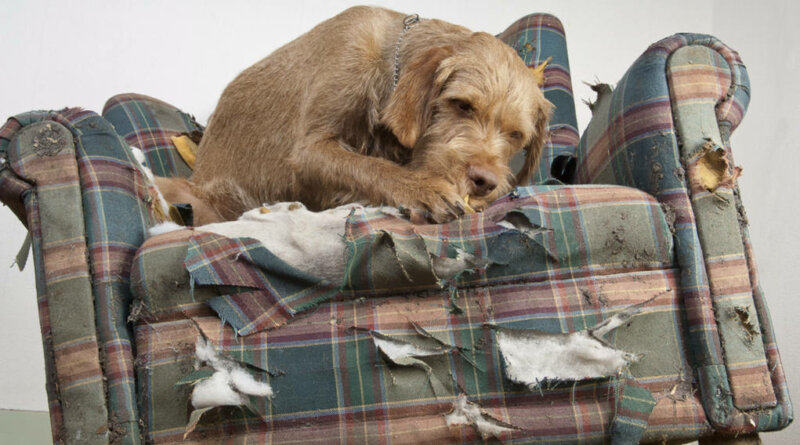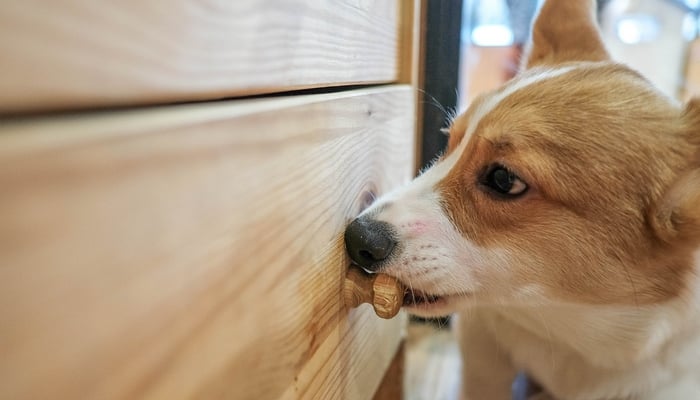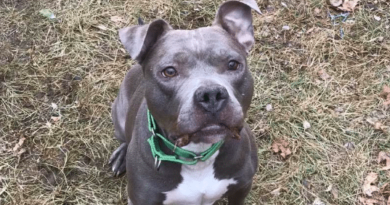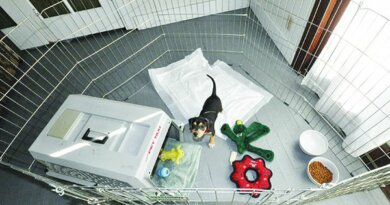15 Ways to Prevent Dogs from Chewing Furniture and Your Belongings
You turn your back for just a moment, and you’ve lost a precious item because it’s been chewed to bits by your dog. It happened to every dog owner. Fortunately, there are many ways to prevent dogs from chewing furniture, crates, beds and other belongings, but some owners are confused because they don’t know which methods are most effective.
When it comes to dog chewing up things incessantly, the problem can be far more serious and complicated than simply losing your stuff to your dog’s destructive behavior. Pet owners find themselves taking their dogs to the vet because they’ve eaten something they’ve shouldn’t have, broken a tooth, hurt himself or were choking.
Dogs have evolved to chew on something constantly, researchers say. Every dog chews to some degree, and chewing itself should not be discouraged because it’s beneficial for the dog’s mental and physical health. You must only redirect a dog’s chewing behavior away from inappropriate items and onto things the dog is allowed to chew on.
The first line of defense against destructive chewing in dogs, and to prevent dogs from chewing furniture or belongings is pet-proofing your home. After that, there are a few more additional ways to prevent dogs from chewing inappropriate items, so here are some tips you can implement with your pets.
15 Ways to Prevent Dogs from Chewing Stuff
1 A Hungry Dog
A dog that is hungry will have extra incentive to destroy your belongings and furniture. He’s more likely to chew whatever he can while looking for new sources of nutrition, or he simply distracts himself from hunger that way. This behavior is more common in puppies who are not yet properly adjusted to regular feeding regimen.
To prevent dogs from chewing, first check they’re getting enough calories in their diet for the dog’s size, breed and activity level. Malnutrition, a calorie-restricted diet or inefficient supply of nutrients in dog food can cause chewing in dogs for other reasons, too.
2 Teething in Puppies
The process of teething in dogs – a puppy developing adult teeth – can last anywhere from 6 to 8 months. It starts when puppies are around 4 to 6 months old. That’s not the end of it, though.
It can take as long as 18 months for a puppy’s new teeth to set in. That can be an irritating experience for some dogs, and chewing is a natural way for them to deal with this experience.
Good quality and especially long-lasting puppy toys for teething will help manage this. Remember to not discourage chewing in puppies but rather redirect them to chew on more appropriate things such as said puppy toys or puppy chews.
3 Early Separation
Your puppy’s mother is not only his guardian and protector but also his trainer and example of what to do in the new world. As the nature has intended, all dogs should learn about biting manners from their mothers and their litter mates – brothers and sisters.
If a puppy has been separated from his canine family much too early, then biting, chewing and sucking are more likely to be a problem that can last for the rest of the puppy’s life.
Dogs might also chew more because of separation anxiety after being left alone in the house. While it’s too late when you already have a separated puppy at home, it’s something to keep in mind for future dog owners looking to adopt a new puppy.
4 Give Your Dog More Attention
A dog’s biting and chewing behavior is sometimes focused on a particular person in the family because the dog wants their attention, even if their reaction is negative. The best way to prevent dogs from chewing and biting is to play mouth and chew related games, and have dog chew toys available. But do not encourage inappropriate chewing during this playtime.
Boredom is another huge factor and one of the main reasons dogs chew on things. Studies show that mental stimulation can prevent dogs from chewing and fix other negative behaviors.
So if your dog is bored, make sure he gets enough activity to stay out of trouble. Keep your dog exercise levels up, and stimulate him with interactive toys or dog games to keep him tired and less likely to chew or bite.
5 The Importance of Mouthing
Like human babies, puppies explore the world with their mouths by biting, licking, chewing and tasting. Even as adults, the mouth plays a much more important sensory role for dogs than it does for humans. It’s how dogs experience and understand their surroundings.
It takes training to teach dogs how to limit the use of their mouths to what’s acceptable, but you need to see mouth use as natural and fundamental dog behavior. Enrich your pet’s environment with appropriate items he can put in his mouth. Chewing, biting and mouthing in puppies is often related.
6 Observe and Offer Better Chewing Choices
Try to catch your dog before he really starts chewing on your furniture, slippers or something else inappropriate. With some regular observation, you’ll know the signs of when your dog is looking for things to chew on and destroy.
Keep better chewing items at the ready, and make a quick, calm trade once the behavior starts. You don’t want to discourage your pooch from what’s perfectly natural – let him chew on things – but simply redirect the dog and provide better and safer options.
7 Beware of Bones
Unlike manufactured bones for chewing, cooked bones like chicken bones are not safe and should not be given to dogs. They are softened by the cooking process and can splinter and shatter, which may cause a broken tooth, jaw injury or pose a choking hazard for dogs.
Pieces of cooked bones can get caught in the dog’s windpipe, esophagus, stomach or intestines and cause injury. Moreover, raw bones like chicken and turkey wings or necks might be edible, but dogs can spread bacteria throughout the house and to their owners.
If you do feed your dog edible bones, make sure they’re only for inside his dog crate or other easy-to-clean areas. Alternatively, you can buy irradiated bones. Big bones and antlers shouldn’t be offered without supervision either, because they can break dog’s teeth too. The richness of bone marrow can also cause diarrhea in dogs.
8 Try Safe Dog Chew Toys and Foods
Redirection is a great way to prevent dogs from chewing furniture or your belongings. Instead of allowing your pet to chew on slippers, get him something else to sink his teeth into. Separation anxiety toys, dog chews and interactive dog toys, puppy teething toys are all good choices.
For example, some of the safe and effective chew toys for dogs include:
- Stuffed KONG toys, currently considered some of the best and most affordable dog toys on the market, particularly their puzzle toys;
- Tendon chews of the correct size;
- Dental dog chews – great for not only redirecting your pet’s chewing behavior but also for cleaning his teeth and keeping his gums healthy;
- Frozen treats, ropes or some type of other DIY toys for dogs;
- Hooves, which are tough to chew on and may last a little longer than regular edible treats and dental chews;
- Himalayan chews because most of them are made from hard yak milk cheese;
- Bully sticks and (some) bones – a very popular among pet owners and loved by most dogs, they are larger than the size of your dog’s jaw and will keep him occupied;
- Organic pig ears or other animal ear chews – they won’t last as long as certain chews but most dogs love the taste and texture of these treats;
- Kibble – you can use it as dog treats, and it’s going to be lower in calories;
- Most durable chew toys that can’t be torn to pieces easily and quickly (often, separation anxiety toys will be some of the most durable out there).
In some cases, dog toys made in China may not be the best option. When you’re buying something that you expect to be destroyed eventually, there’s a chance a dog will swallow it. China-made dog toys are much more likely to break and increase the chance of your dog swallowing some toxic materials or pose a choking hazard.
9 Watch What You Communicate to Your Dog
Stay consistent with your own commands and behavior if you want to prevent dogs from chewing long-term. If you get angry or display too much (positive for the dog) emotion, you might create a regular chewing target or make a game out of the biting behavior.
When your dog nips at your mittens or pant legs, and you shout or act hurt, it might work temporarily, but most dogs know you’re not really hurt. Usually, this looks like playtime to a dog, and can get your pet even more excited to continue this practice.
Likewise, if you give a dog an old shoe to chew on, he’ll learn chewing on shoes is okay. The worst thing you can do when trying to prevent dogs from chewing is to chase him around – that’s a fun game for them.
10 Use Effective Training Techniques
There is no substitute for dog training. The best way to teach them anything is to use positive reinforcement and reward a dog for good behavior. Don’t punish your dog such as holding your dog’s mouth shut, because that’s only a temporary solution that doesn’t actually correct their behavior.
Studies have shown that punishment will only encourage bad or aggressive behavior in dogs. It’s better to supervise your pet until you’re confident he won’t destroy things and stops chewing on your furniture, and praise him for chewing appropriate items.
11 Timing and Discipline
Dogs live in the now. You have to catch your dog in the act if you’re going to teach him anything. Scolding him afterwards isn’t going to work, because they will not understand what they’re being punished for. Their reaction is just submissive behavior.
Even if your dog looks guilty, it’s not connected to what your dog did in the past, even if it was just a few minutes ago. Therefore, make sure that whatever dog training or behavior correction techniques you’re using, that they’re always timed correctly.
12 Limit Where Your Dog Can Go
The best way to prevent dogs from chewing is to not allow them access to certain areas, and use boundary training. Crate your dog, or use pet gates to temporarily limit his movement, especially if he’s unsupervised. Dogs will also chew when they want to escape, so don’t leave them confined for too long.
However, using crates and gates is only a temporary solution, and is best used alongside proper dog training and redirection techniques.
13 Keep Important Items Out of Reach
Teach your dog to accept that certain areas of the house are never accessible and out of bounds for him, like closets. Keep your important belongings away from the dog.
If you’re the one that left something out to tempt your pooch when he wasn’t supervised, you’re the one to blame for teasing. Spilled food and drinks will also make furniture more attractive for chewing, so keep things clean.
14 Teach the “Drop It” Command
Regular dog training is the best way to teach your dog obedience. Use the “drop it” command frequently to give the dog lots of practice.
You can easily combine this with a game of fetch, which can benefit you and your canine on different levels: train him, exercise him and stimulate him mentally to keep him exhausted and tired, not wanting to chew on anything.
15 Make Things Taste Bad
Finally, using dog repellents and deterrents is an easy, convenient and safe way to discourage dogs from certain behaviors, and prevent dogs from chewing furniture or other things.
Bitter deterrents can be applied to furniture and other belongings to prevent dogs from chewing. They’re available in sprays and gels, and should be used daily. However, some dogs might find the taste of some deterrents enticing, so you may need to try another one if the first one doesn’t get a strong enough negative reaction from your pooch.
Some of the best dog repellents that worked for us in the past are these:
READ NEXT: 20 Most Effective Ways to Mentally Stimulate Your Dog






